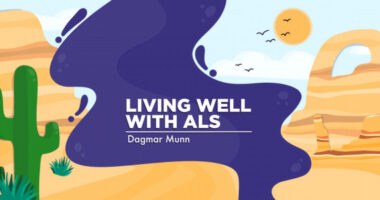How I’m now dancing to the beat of my own ALS
I'm learning to help myself by embracing my body's changing rhythms

I used to take for granted my ability to sync up with the people and events in my life — to keep up with conversations, move in unison with my fellow dancers, and show up on time. But that was before ALS waltzed into my life.
At first, the changes were subtle, such as a slight feeling of being out of step and a beat behind almost everything. It’s a sensation many of us who live with ALS experience.
But instead of fighting against my body’s new rhythm, I’ve found myself embracing it.
In college, I majored in dance education, and we studied the concept of entrainment. It’s when our bodies or things in our environment synchronize their rhythms. Think of fireflies blinking in unison on a warm summer night, or a crowd of people spontaneously clapping to the beat of a song. It’s a powerful, often unconscious, connection.
We were encouraged to observe entrainment in as many situations as we could find. I’d marvel at how, stuck in a pack of speeding cars on the highway, I’d feel an urge to press the accelerator and match their pace. In conversations, I’d notice myself speeding up to keep stride with fast talkers, while the calm demeanor of others would gently slow me down.
My favorite place to observe entrainment, though, was the dance floor at wedding receptions. The majority of guests would be moving and gyrating to the DJ’s music, a sea of synchronized gaiety. But not everyone was a natural.
There were always a few who tried so hard to mimic the others, their movements becoming more awkward with every strained attempt to catch the beat. And then, off to the side, there was always that one older couple. No matter how up-tempo the song, they’d be swaying gently, doing a simple two-step, completely engrossed in their own private rhythm. They were dancing to a beat only they could hear, and it was beautiful.
A dose of reality
Just last week I sat, exasperated, trying to rush through getting ready for lunch with friends. The more I pushed myself to move faster, the more my body resisted. “Come on, Dagmar,” I muttered, bending over to pick up the shoe that had slipped from my hand, “you used to be able to do this.” The frustrating truth about ALS is that it forces us to confront our losses, to focus on what we used to do easily.
But then, a memory surfaced of that older couple, dancing to their own quiet rhythm. And a wave of understanding washed over me. I don’t have to entrain with my former zippy self, nor do I need to keep pace with the faster rhythms of others around me. I’m living in the ALS slow lane now, and that’s OK.
For me, learning to live well with ALS, to embrace this new chapter, means adopting a mindset of acceptance. It means accommodating my body’s ebb and flow of energy, honoring its new tempo and my unique rhythm. Just like that couple on the dance floor, I’m learning to move to my own beat, and I believe it’s something you can do as well.
Note: ALS News Today is strictly a news and information website about the disease. It does not provide medical advice, diagnosis, or treatment. This content is not intended to be a substitute for professional medical advice, diagnosis, or treatment. Always seek the advice of your physician or other qualified health provider with any questions you may have regarding a medical condition. Never disregard professional medical advice or delay in seeking it because of something you have read on this website. The opinions expressed in this column are not those of ALS News Today or its parent company, Bionews, and are intended to spark discussion about issues pertaining to ALS.







Teresa Donahue
Dagmar; I would like to follow your blog- how do I find it? Looking forward to reading more about your experience living with ALS and your advice and counsel.
Teresa
Dagmar Munn
Hello Teresa, thank you for asking about my blog. Use this link: https://alsandwellness.blogspot.com/2015/01/welcome.html ... use the tabs at the top of the page for and index of all my posts and also for the current post. Best, Dagmar
Jane Torkelson
Thank you, Dagmar. That might be my new motto: 'Living in the slow lane.' :)